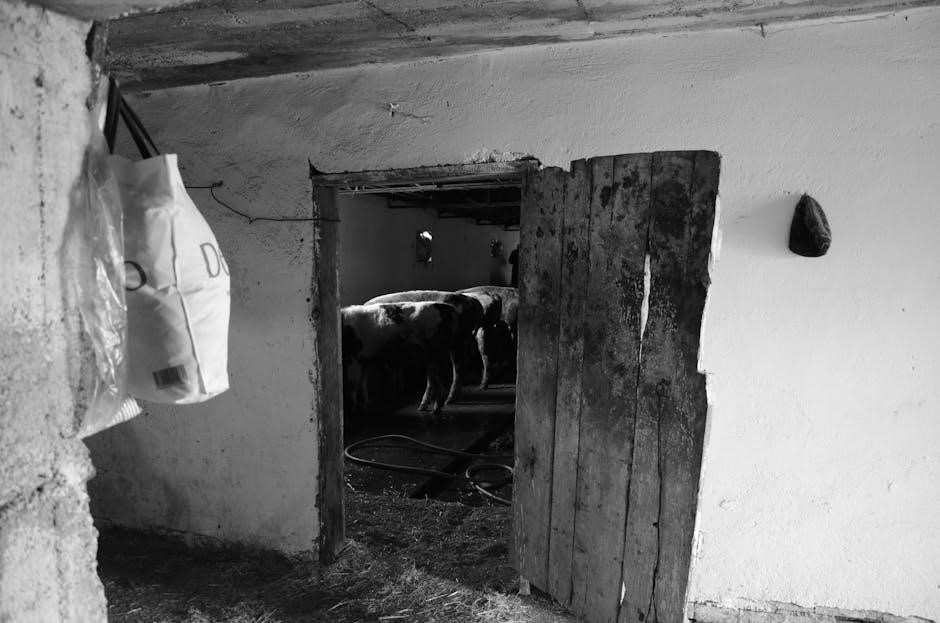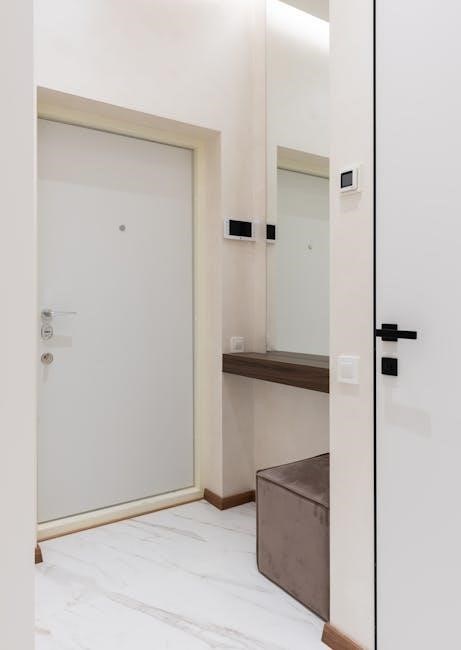
barn door floor guide wall mount
Barn Door Floor Guide Wall Mount: An Overview
A wall-mounted barn door floor guide is a hardware component designed to keep your barn door aligned and prevent swinging. Unlike floor-mounted guides, it attaches to the wall, offering a cleaner look.

What is a Barn Door Floor Guide?
A barn door floor guide is a crucial, often small, piece of hardware designed to ensure the smooth and stable operation of a sliding barn door. Its primary function is to prevent the door from swinging outwards or rubbing against the wall as it slides open and closed. Think of it as a subtle yet essential component that keeps your barn door aligned and moving along its intended path.
Essentially, it’s a guide, typically made of metal or plastic, installed at the bottom of the barn door. It interacts with the floor (or the wall in the case of a wall-mounted guide) to maintain the door’s position. The guide keeps the door from wobbling, preventing potential damage to the door itself, the wall, or anything nearby. It contributes to the longevity of the barn door hardware. Ultimately, it provides smooth and quiet operation.

Why Use a Floor Guide?
A floor guide is essential for any barn door installation. Without it, the door would swing freely, causing potential damage to both the door and the surrounding walls. Imagine a heavy door swaying back and forth with each use; the constant impact could lead to unsightly dents and scratches, not to mention the noise and instability.
Beyond protection, floor guides contribute to the smooth and quiet operation of the barn door. By keeping the door aligned, the guide ensures it glides effortlessly along the track. This prevents the door from getting stuck or making jarring sounds. A floor guide enhances the overall functionality and lifespan of your barn door system, adding a touch of elegance and practicality to your space.

Types of Barn Door Floor Guides
Various barn door floor guides exist, including U-channel, T-guide, C-guide, and roller guides. Each type offers unique benefits based on door style, floor type, and desired aesthetic.
U-Channel Guide
The U-channel guide is a popular choice, featuring a channel attached to the floor. This design ensures the door remains perfectly aligned during its sliding motion. It prevents wobbling and ensures smooth operation. It’s a very simple and functional solution for many barn door setups.
This type of guide encases the bottom edge of the door. This is ensuring stability and preventing it from swinging outward. Installation is generally straightforward, involving securing the channel to the floor. The U-channel guide is suitable for various barn door styles and thicknesses.
Consider the U-channel guide if you need a reliable and unobtrusive solution. It will maintain your barn door’s alignment. It also offers a clean look and prevents unnecessary movement during operation. It is also a great choice for DIY barn door projects.
T-Guide
The T-guide is another common type of barn door floor guide. It comes standard with various sliding door kits, indicating its widespread use and reliability. Its design typically involves a small metal or plastic piece shaped like a “T” that is mounted to the floor. The barn door then slides along this guide.
The T-guide prevents the door from swinging back and forth as it opens and closes. This ensures smooth and controlled movement. Installation is usually simple, requiring only a few screws to secure the guide to the floor. The low profile of the T-guide makes it relatively unobtrusive.
T-guides are often preferred when a minimalist aesthetic is desired. They are a cost-effective and practical solution for maintaining barn door stability. This is also keeping them aligned, and preventing unwanted movement. It is a great choice for any barn door project.
C-Guide
The C-guide is a popular option due to its sleek and low-profile design. This type of floor guide is often chosen for its aesthetic appeal. The “C” shape cradles the bottom of the barn door, ensuring it stays on its track.
C-guides are typically made from metal or durable plastic. They offer a smooth and quiet operation. The design minimizes friction and noise as the door slides open and closed. Installation usually involves attaching the guide to the floor with screws, making it a straightforward process.
The C-guide’s unobtrusive appearance allows it to blend seamlessly with various interior styles. It provides reliable door stability without being visually distracting. This makes it a favorite among homeowners and designers. Its combination of functionality and aesthetics makes it a great choice.
It is a great choice for those seeking a modern and refined look.
Roller Guide
A roller guide utilizes a small wheel or roller to guide the barn door along its path. This type of guide is designed to provide a smooth and quiet operation. The roller minimizes friction, allowing the door to glide effortlessly.
Roller guides can be mounted to the floor or the wall, depending on the specific design and installation requirements. They are often adjustable, allowing for fine-tuning to ensure proper door alignment. The roller is typically made from durable materials such as nylon or metal, ensuring longevity.
One advantage of roller guides is their ability to accommodate doors of varying thicknesses. The adjustable roller can be positioned to fit snugly against the door, preventing wobbling and ensuring smooth movement. This makes them versatile.
Roller guides are a great choice for those seeking a reliable and easy-to-use solution for keeping their barn doors on track. Their smooth operation and adjustability make them a popular choice for both residential and commercial applications.

Floor Mounted vs. Wall Mounted Guides
The choice between floor-mounted and wall-mounted barn door guides depends on several factors, including aesthetics, practicality, and installation ease. Floor-mounted guides are installed directly onto the floor, providing a stable and secure way to keep the door on track. They are particularly useful for heavier doors.
However, floor-mounted guides can be a tripping hazard and may interfere with flooring. Wall-mounted guides, on the other hand, attach to the wall and offer a cleaner, more streamlined look. They eliminate the risk of tripping and don’t affect the flooring.
Wall-mounted guides are ideal for situations where you want to minimize visual clutter or if floor installation is not feasible. They are generally easier to install, requiring fewer tools and less effort. The decision ultimately comes down to personal preference.
Consider the pros and cons of each type to determine which best suits your needs and aesthetic goals. Both options effectively guide.

Choosing the Right Floor Guide
Selecting the appropriate floor guide for your barn door involves careful consideration of several factors. First, assess the thickness of your barn door, as this will determine the required width of the guide. Ensure the guide can comfortably accommodate the door without binding or causing friction during operation. Next, consider the style of your barn door and choose a guide that complements its aesthetic.
Options range from minimalist designs that blend seamlessly to more decorative styles that enhance the door’s visual appeal. Evaluate the available space around the door opening. If space is limited, a compact guide may be necessary. Finally, think about the ease of installation.
Wall-mounted guides generally offer simpler installation compared to floor-mounted options. Check customer reviews and product specifications to ensure the guide is durable and reliable. By thoughtfully weighing these factors, you can select a floor guide that provides optimal functionality, enhances the appearance of your barn door, and ensures long-lasting performance. A well-chosen guide will keep your door aligned.

Essential Supplies for Installation
Before embarking on the installation of your barn door floor guide, gathering the necessary supplies is crucial for a smooth and efficient process. Firstly, you’ll need a measuring tape to accurately determine the placement of the guide and ensure proper alignment with the barn door. A pencil is essential for marking the desired location of the guide on the wall or floor, providing a clear reference point during installation.
A drill with appropriate drill bits is required for creating pilot holes and securely fastening the guide to the surface. Depending on the type of surface you’re working with, you may also need anchors or wall plugs to ensure a stable and secure attachment. A screwdriver, either manual or powered, will be necessary for tightening the screws that hold the guide in place.
A level is indispensable for ensuring that the guide is perfectly aligned, preventing any unevenness or friction during the door’s operation. Safety glasses and work gloves are highly recommended to protect your eyes and hands throughout the installation process. Finally, consider having a stud finder handy to locate wall studs for a more secure and stable mounting point, especially for wall-mounted guides. Having these supplies readily available will streamline the installation process.

Step-by-Step Installation Guide: Floor Mounted
Installing a floor-mounted barn door guide involves precise placement, marking the screw locations, pre-drilling pilot holes, and securely fastening the guide to the floor, ensuring smooth door operation.
Determining Placement
The correct placement of your floor-mounted barn door guide is crucial for ensuring the door operates smoothly and remains stable. Begin by sliding the barn door to its fully closed position. Then, carefully assess where the guide needs to be positioned to prevent any wobbling or swinging.
The guide should be close enough to the door to maintain consistent contact but not so tight that it hinders the door’s movement. Consider the type of guide you are using; U-channel guides need to be positioned so the door slides neatly within the channel, while roller guides should align with the door’s bottom edge.
Use a level to ensure the guide will be perfectly aligned with the floor. This prevents uneven wear and tear on the door and guide. Mark the desired location on the floor with a pencil, taking into account any slight adjustments that may be needed once the door is tested in motion. Remember, precise placement will guarantee proper functionality.
Measuring and Marking
Accurate measuring and marking are essential steps for a successful floor-mounted barn door guide installation. Once you’ve determined the optimal placement, precisely measure the distance from the wall to the center of the door’s path. This measurement will ensure the guide aligns perfectly, preventing any friction or misalignment.
Using a measuring tape, carefully record this distance and transfer it to the floor where you plan to install the guide. Use a pencil to clearly mark the points where the guide will be secured. Double-check these measurements to avoid errors that could lead to operational issues;
For U-channel guides, ensure the marked area is wide enough to accommodate the channel’s width. For roller guides, verify the mark aligns with the intended roller position. Precise markings guarantee the guide is installed correctly, allowing the barn door to glide smoothly and remain stable throughout its range of motion. Attention to detail during this stage saves time and frustration later.
Securing the Guide
After accurately measuring and marking the floor, the next crucial step is securely attaching the floor guide. For most floor-mounted guides, this involves drilling pilot holes at the marked locations. Pilot holes prevent the wood from splitting and make it easier to drive in screws.
Select drill bits appropriate for the floor material (wood, concrete, etc.) and the size of the screws you’ll be using. Once the pilot holes are drilled, position the floor guide over the holes, ensuring it aligns perfectly with your markings. Using a screwdriver or drill, carefully drive the screws into the pilot holes, tightening them until the guide is firmly attached to the floor.
Avoid over-tightening the screws, which could damage the floor or strip the screw heads. For concrete floors, use appropriate anchors and concrete screws to ensure a secure hold. Periodically check the stability of the guide, especially after initial use, and re-tighten screws if necessary to maintain optimal performance and prevent wobbling.

Step-by-Step Installation Guide: Wall Mounted
Installing a wall-mounted barn door floor guide involves precise positioning and secure attachment to the wall. Follow these steps for a smooth and successful installation, ensuring optimal door alignment and functionality.
Positioning the Guide
The first step in installing a wall-mounted barn door floor guide is accurately positioning it. Begin by closing the barn door and identifying where it naturally rests. This will be the ideal location for the guide to prevent any unwanted swinging or movement when the door is closed.
Next, consider the type of wall-mounted guide you have. L-shaped guides, for example, fit snugly against the wall’s edge. Hold the guide in place, ensuring the door glides smoothly within it. Mark the wall where the guide will be attached, using a pencil for precision.
Double-check that the marked position allows the door to move freely without obstruction. A slight adjustment at this stage can save you from headaches later. Remember, accuracy is key to a properly functioning barn door system. This precise positioning guarantees the door stays aligned during each use.
Attaching to the Wall
Once you’ve precisely positioned your wall-mounted barn door floor guide, it’s time for the crucial step of attaching it to the wall. First, pre-drill pilot holes at the marked locations. This prevents the wood from splitting, especially if you’re working with drywall; use appropriate wall anchors for added stability.
Align the guide with the pilot holes. Using screws that are suitable for the wall material, begin fastening the guide. Ensure the screws are tightened securely, but avoid over-tightening, which could damage the guide or the wall. Check the guide’s stability. It should be firmly attached and not wobble.
For heavier doors or high-traffic areas, consider using longer screws or additional anchors for enhanced support. Finally, test the door’s movement within the guide. It should glide smoothly and remain aligned. Make any necessary adjustments to the guide’s position if needed. This secure attachment is key for long-lasting performance.
Troubleshooting Common Issues
Even with careful installation, some issues might arise with your barn door floor guide. One common problem is the door rubbing against the guide. This can be due to misalignment or a guide that’s too tight. Loosen the guide slightly or adjust its position to allow for smoother movement. If the door is still rubbing, check for any obstructions on the floor or within the door’s track.
Another issue is the guide becoming loose over time. This is often caused by vibrations from the door’s movement. Regularly inspect the screws and tighten them as needed. If the screw holes are stripped, use longer screws or wall anchors for a more secure hold.
Sometimes, the door might jump out of the guide. This usually happens if the guide is too wide or if the door is being pushed too forcefully. Adjust the guide’s width or consider adding a second guide for added stability. By addressing these common issues promptly, you can ensure your barn door operates smoothly and safely for years to come.

Maintenance Tips for Longevity
To ensure the longevity of your barn door floor guide, regular maintenance is essential. Start by periodically inspecting the guide for any signs of wear and tear. Check for loose screws, cracks, or damage to the guide itself. Tighten any loose screws immediately to prevent further issues.
Clean the guide regularly to remove dust, dirt, and debris that can accumulate over time. Use a soft cloth and mild soap to wipe down the guide. Avoid using harsh chemicals or abrasive cleaners, as these can damage the finish. Lubricate any moving parts of the guide, such as rollers or hinges, with a silicone-based lubricant to keep them functioning smoothly.
Inspect the door itself for any signs of warping or damage that could affect its alignment with the guide. Address any issues promptly to prevent them from causing further damage to the guide or the door. By following these simple maintenance tips, you can extend the lifespan of your barn door floor guide and ensure it continues to function properly for years to come.
Leave a Reply
You must be logged in to post a comment.